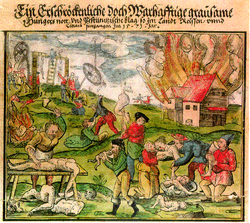 Global Information
Global InformationCannibalism in Europe information

Acts of cannibalism in Europe seem to have been relatively prevalent in prehistory, but also occurred repeatedly in later times, often motivated by hunger, hatred, or medical concerns. Both anatomically modern humans and Neanderthals practised cannibalism to some extent in the Pleistocene,[1][2][3][4] and Neanderthals may have been eaten by modern humans as the latter spread into Europe.[5] Amongst humans in prehistoric Europe, archaeologists have uncovered many clear and indisputable sites of cannibalism, as well as numerous other finds of which cannibalism is a plausible interpretation.
In antiquity, several Greek and Roman authors mention cannibal customs in remote parts of the continent, such as beyond the Dnieper River and in Britain. The Stoic philosopher Chrysippus noted that burial customs varied widely, with funerary cannibalism being practised by many peoples, though rejected by the Greek. Several cases of survival cannibalism during sieges are on record. Cannibalism to face off starvation was also practised in later times, such as during the Great Famine of 1315–1317. In the early modern and colonial era, shipwrecked sailors ate the bodies of the deceased or drew lots to decide who would have to die to provide food for the others – a widely accepted custom of the sea.
During the First Crusade, some crusaders ate the bodies of killed enemies, with the reasons for these acts (hunger or hatred?) being a matter of debate. Various cases of undoubtedly revenge-driven cannibalism took place in early modern Italy. In 1672, the Dutch statesman Johan de Witt and his brother were lynched and partially eaten by an angry mob. In early modern Europe, the consumption of body parts and blood for medical purposes became popular. Reaching its height during the 17th century, this practice continued in some cases into the second half of the 19th century.[6]
The first half of the 20th century saw a resurgence of acts of survival cannibalism in Eastern Europe, especially during the Russian famine of 1921–1922, the Soviet famine of 1930–1933, and the siege of Leningrad. Several serial killers, among them Karl Denke and Andrei Chikatilo, consumed parts of their victims. A few other people, such as reporter William Seabrook and artist Rick Gibson, ate human flesh out of curiosity or to shock the public, without killing anyone for the purpose. At the start of the 21st century, Armin Meiwes became infamous for killing and eating a voluntary victim, whom he had found via the Internet.
- ^ Culotta, E. (October 1, 1999). "Neanderthals Were Cannibals, Bones Show". Science. 286 (5437). Sciencemag.org: 18b–19. doi:10.1126/science.286.5437.18b. PMID 10532879. S2CID 5696570.
- ^ Gibbons, A. (August 1, 1997). "Archaeologists Rediscover Cannibals". Science. 277 (5326). Sciencemag.org: 635–637. doi:10.1126/science.277.5326.635. PMID 9254427. S2CID 38802004.
- ^ Rougier, Hélène; Crevecoeur, Isabelle; Beauval, Cédric; Posth, Cosimo; Flas, Damien; Wißing, Christoph; Furtwängler, Anja; Germonpré, Mietje; Gómez-Olivencia, Asier; Semal, Patrick; van der Plicht, Johannes; Bocherens, Hervé; Krause, Johannes (July 6, 2016). "Neandertal cannibalism and Neandertal bones used as tools in Northern Europe". Scientific Reports. 6 (1): 29005. Bibcode:2016NatSR...629005R. doi:10.1038/srep29005. ISSN 2045-2322. PMC 4933918. PMID 27381450.
- ^ Davis, Josh (October 4, 2023). "Oldest evidence of human cannibalism as a funerary practice". Natural History Museum – Science News. Retrieved February 26, 2024.
- ^ McKie, Robin (May 17, 2009). "How Neanderthals Met a Grisly Fate: Devoured by Humans". The Observer. London. Retrieved May 18, 2009.
- ^ Sugg, Richard (2015). Mummies, Cannibals and Vampires: The History of Corpse Medicine from the Renaissance to the Victorians. Routledge. pp. 122–125 and passim.